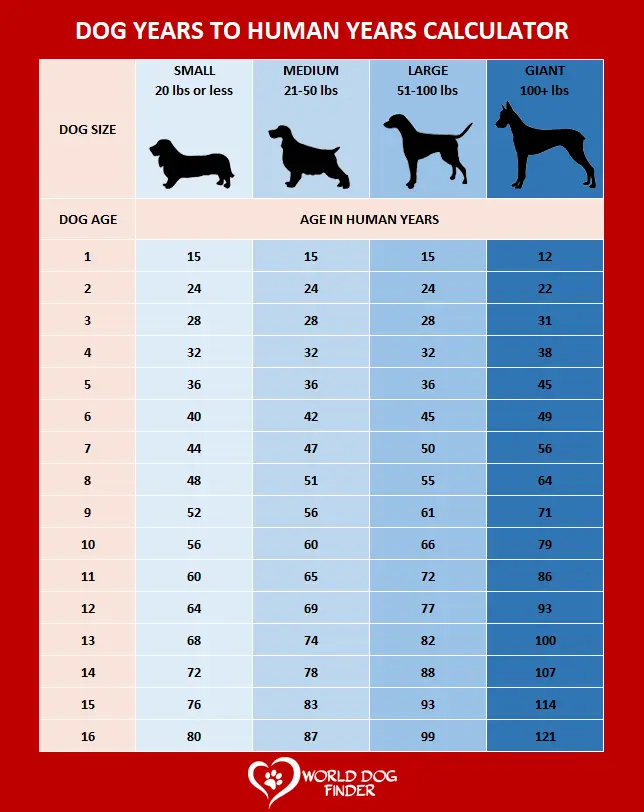Dog Years to Human Years - What Is The Best Calculator?
14.02.2021.
There is a longstanding belief among dog owners that one human year equals seven dog years. Most of us have heard it, and if you have ever been to a dog park or talked about dog age with other owners, you have probably heard it too. The truth is that is an outdated and not-so-accurate concept. The exact formula goes a bit differently.
Dog year calculator
Remember that there is no exact scientific method to calculating dog years in human years and that this is supposed to let you know how fast dogs are aging. Also, the calculator works differently for different dog breeds. It would be impossible to use the 1-7 method for breeds with a long lifespan. That would mean Chihuahuas often live to be 119 “dog years” old.
Large dog breeds like the Great Dane or Bernese Mountain Dog have a shorter life expectancy than smaller breeds like the Havanese or Pomeranian. According to the American Veterinary Medical Association, the chart of dog years to human years looks something like this:
Average dogs
- 1-year-old dog - A 1-year-old would be equal to a 15-year-old teenager. Dogs mature relatively fast and reach sexual maturity at 6 - 12 months.
- The second year - The second year of your dog’s life is when they mature the most and go through puberty. The second year of your dog’s life would equal 9 human years.
- Every additional year - Every year after the first two years of your dog’s life is roughly 5 human years. That would mean that a 3-year-old dog is like a 28 or 29-year-old human.
This should only be used as a general calculator and should be adjusted based on different breeds. Some dog breeds, like the Boxers or Alaskan Malamutes, reach maturity a lot later in life than other breeds, and the calculator should adjust for that. Each dog is an individual, just like every human is an individual that matures at their own unique pace.

Where it all started?
The 7-to-1 ratio started in the 1950s after an initiative to educate the general public about the need for regularly taking your dog to the vet. Those numbers were based on the average human lifespan in the 1950s, which was 70, and the average dog lifespan which was 10. The goal was to get dog owners to get their dogs checked out at least once a year.
The calculation might be wrong, but the initiative is a great one. Dogs need vet appointments more frequently than we need doctor appointments. Their bodies develop faster, and the accelerated growth might cause some problems, especially with the largest breeds. Their shorter lifespan has baffled scientists for years, and they have yet to confirm why smaller dogs live longer than giant ones.

Lifespan of different-sized breeds
When it comes to size difference and longevity, it looks like our furry companions have it all backward. In nature, giant mammals like whales or elephants live longer than tiny land mammals like mice or rabbits. It is only in canines that larger specimens live shorter than smaller ones.
Scientists have struggled to confirm the exact reason, and they haven’t even conducted such long experiments. They would be impractical and inconclusive, but they are adamant about understanding and discovering the right answer. The University of Göttingen in Germany, with the lead researcher Cornelia Kraus, organized research to understand this problem. Their conclusion is that the life expectancy is shortened by one month for every 4.4 pounds of their body weight.
They mentioned that there are several reasons for that. The first one is that larger dogs succumb to age-related health issues a lot faster than smaller dogs. The second possible reason is that the accelerated growth in large dog breeds leads to a great possibility of deformation and mutation of cells, which results in cancer development.
The good news is that scientists and vets are planning to conduct more experiments aimed at unmasking this age-old question.
Health issues with senior dogs
As our dogs mature, they start experiencing some health issues. The same goes for humans; we can experience decreased motion ability, declining stamina, arthritic pains, stiff joints, vision and hearing problems, etc. Our dogs can experience the same issues, which is another parallel we can draw between dog and human years. Some of the most common health issues senior dogs can experience are:
- Decreased motion
- Poor eyesight
- Graying hair
- Stiff muscles
- Stiff joints
- Arthritis
- Low energy
- Anxiety
- Confusion
- Problems with incontinence
However, senior dogs are charming, and they can offer us plenty of benefits. They won’t require a crazy amount of exercise, and they are a lot more likely to enjoy a peaceful day at the house, cuddling with their owners. There is a unique charm that comes with senior dogs.

Why is it important to understand your dog’s age?
You should understand what certain age brings to your dog for many reasons. It is the best way to understand how to approach the training and what to keep an eye on. If a younger dog has ankle problems, they are more likely injured. Still, if a senior dog has painful ankles, you might want to consider getting them on supplements that help arthritic pains.
World Dog Finder team







Share